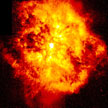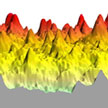Showing Spotlights 121 - 128 of 213 in category All (newest first):
 Trace detection of explosives generally involves the collection of vapour or particulate samples and analyzing them using a sensitive sensor system. Various factors, such as wide variety of compounds that can be used as explosives, the vast number of deployment means and the lack of inexpensive sensors providing both high sensitivity and selectivity have made trace detection a very complex and costly task. High sensitivity and selectivity, along with the availability of low-cost sensors, is essential to combat explosives-based terrorism. Nanosensors have the potential to satisfy all the requirements for an effective platform for the trace detection of explosives.
Trace detection of explosives generally involves the collection of vapour or particulate samples and analyzing them using a sensitive sensor system. Various factors, such as wide variety of compounds that can be used as explosives, the vast number of deployment means and the lack of inexpensive sensors providing both high sensitivity and selectivity have made trace detection a very complex and costly task. High sensitivity and selectivity, along with the availability of low-cost sensors, is essential to combat explosives-based terrorism. Nanosensors have the potential to satisfy all the requirements for an effective platform for the trace detection of explosives.
Jan 28th, 2013
 The media play an important role in the formation of society's opinion by drawing attention to selected topics and bringing them closer to the public. This applies in particular to areas with which a large percentage of the population would otherwise have no direct points of contact, such as nanotechnology. A new study of selected print media in the German-speaking countries now reveals the general picture of nanotechnology in the media, what topics are given significant treatment, which actors are consulted, and explains that (at least as yet) there is no need for any concerns about risk-centred controversial reporting on this technology.
The media play an important role in the formation of society's opinion by drawing attention to selected topics and bringing them closer to the public. This applies in particular to areas with which a large percentage of the population would otherwise have no direct points of contact, such as nanotechnology. A new study of selected print media in the German-speaking countries now reveals the general picture of nanotechnology in the media, what topics are given significant treatment, which actors are consulted, and explains that (at least as yet) there is no need for any concerns about risk-centred controversial reporting on this technology.
Jan 21st, 2013
 Nanotechnology can play a significant role in the construction industry and stands at eighth position in terms of most significant areas of applications in nanotechnology. Nanoengineering of cement-based materials can result in outstanding or smart properties. Introduction of nanotechnology in cement industry has the potential to address some of the challenges such as CO2 emissions, poor crack resistance, long curing time, low tensile strength, high water absorption, low ductility and many other mechanical performances.
Nanotechnology can play a significant role in the construction industry and stands at eighth position in terms of most significant areas of applications in nanotechnology. Nanoengineering of cement-based materials can result in outstanding or smart properties. Introduction of nanotechnology in cement industry has the potential to address some of the challenges such as CO2 emissions, poor crack resistance, long curing time, low tensile strength, high water absorption, low ductility and many other mechanical performances.
Dec 17th, 2012
 Energy-relevant materials like selenium have photovoltaic and photoconductive properties that make them interesting for the manufacture of solar cells and lighting devices. In most of these applications, as with all nanomaterials, the material surface plays a critical role. Therefore, their surface properties, and more particularly their solid surface energy - the energy required to create a new surface - have to be carefully determined in order to fully understand and control relevant manufacturing parameters for devices based on these materials.
Energy-relevant materials like selenium have photovoltaic and photoconductive properties that make them interesting for the manufacture of solar cells and lighting devices. In most of these applications, as with all nanomaterials, the material surface plays a critical role. Therefore, their surface properties, and more particularly their solid surface energy - the energy required to create a new surface - have to be carefully determined in order to fully understand and control relevant manufacturing parameters for devices based on these materials.
Dec 11th, 2012
 Nanoscience and nanotechnology have emerged as important priorities not only for science but also for economic development. In this article, the authors propose an analytical framework that considers the socioeconomic effects of nanotechnology in six key areas: institutional development, knowledge flows, and network efficiency; research and education capabilities; industrial and enterprise development; regional spread; cluster and network development; and product innovation. This framework is applied to assess the early impacts of the evolving domain of nanotechnology for development, with a focus on China and its transitioning economy.
Nanoscience and nanotechnology have emerged as important priorities not only for science but also for economic development. In this article, the authors propose an analytical framework that considers the socioeconomic effects of nanotechnology in six key areas: institutional development, knowledge flows, and network efficiency; research and education capabilities; industrial and enterprise development; regional spread; cluster and network development; and product innovation. This framework is applied to assess the early impacts of the evolving domain of nanotechnology for development, with a focus on China and its transitioning economy.
Dec 5th, 2012
 Power dissipation is the limiting factor to the continued scaling of size and speed of conventional silicon technology used for fabrication of integrated circuits and computer chips. For each switch of a transistor, an amount of energy needs to be dissipated that is proportional to the number of electrons and temperature. This condition is of a fundamental nature, resulting from the laws of thermodynamics.However, the assumption underlying this fundamental limit is that the electrons or spins act as an ensemble of independent particles. If instead, the electrons are in a collective state, then the minimum dissipation limit for one switching cycle can be greatly reduced. This fact provides a strong motivation to exploit collective states as alternative variables for information processing.
Power dissipation is the limiting factor to the continued scaling of size and speed of conventional silicon technology used for fabrication of integrated circuits and computer chips. For each switch of a transistor, an amount of energy needs to be dissipated that is proportional to the number of electrons and temperature. This condition is of a fundamental nature, resulting from the laws of thermodynamics.However, the assumption underlying this fundamental limit is that the electrons or spins act as an ensemble of independent particles. If instead, the electrons are in a collective state, then the minimum dissipation limit for one switching cycle can be greatly reduced. This fact provides a strong motivation to exploit collective states as alternative variables for information processing.
Nov 8th, 2012
 Protection against nerve agents - such as tabun, sarin, soman, VX, and others - is a major terrorism concern of security experts. Current methods to detect nerve agents include surface acoustic wave sensors; conducting polymer arrays; vector machines; and the most simple: color change paper sensors. Most of these systems have have certain limitations including low sensitivity and slow response times. Nanoporous material can remove highly toxic nerve agent vapors by physical adsorption. Unfortunately, the broad range of toxic agents, environmental conditions and types of carbonaceous material simply does not allow laboratory testing of every possible combination. New research is now shedding new light on the selection of an optimal nanomaterial for capturing highly volatile nerve agents.
Protection against nerve agents - such as tabun, sarin, soman, VX, and others - is a major terrorism concern of security experts. Current methods to detect nerve agents include surface acoustic wave sensors; conducting polymer arrays; vector machines; and the most simple: color change paper sensors. Most of these systems have have certain limitations including low sensitivity and slow response times. Nanoporous material can remove highly toxic nerve agent vapors by physical adsorption. Unfortunately, the broad range of toxic agents, environmental conditions and types of carbonaceous material simply does not allow laboratory testing of every possible combination. New research is now shedding new light on the selection of an optimal nanomaterial for capturing highly volatile nerve agents.
Nov 7th, 2012
 A new report, which reviews the history of nanotechnology research and development at NASA over the past 15 years, shows that NASA is the only U.S. federal agency to scale back investment in this area. The study argues that nanotechnology has the proven capability of revolutionizing most areas of technology that will be critical to NASA's future missions: The agency needs a bolder plan for R+D to match the requirements of those missions and to recapture its place at the forefront of nanotechnology. But it's not as if NASA doesn't have any ideas as to how nanotechnologies could be used to advance space technologies. In 2010, the agency drafted a 20-year Nanotechnology Roadmap as part of its integrated Space Technology Roadmap. According to this document, nanotechnology can have a broad impact on NASA missions.
A new report, which reviews the history of nanotechnology research and development at NASA over the past 15 years, shows that NASA is the only U.S. federal agency to scale back investment in this area. The study argues that nanotechnology has the proven capability of revolutionizing most areas of technology that will be critical to NASA's future missions: The agency needs a bolder plan for R+D to match the requirements of those missions and to recapture its place at the forefront of nanotechnology. But it's not as if NASA doesn't have any ideas as to how nanotechnologies could be used to advance space technologies. In 2010, the agency drafted a 20-year Nanotechnology Roadmap as part of its integrated Space Technology Roadmap. According to this document, nanotechnology can have a broad impact on NASA missions.
Oct 23rd, 2012
 Trace detection of explosives generally involves the collection of vapour or particulate samples and analyzing them using a sensitive sensor system. Various factors, such as wide variety of compounds that can be used as explosives, the vast number of deployment means and the lack of inexpensive sensors providing both high sensitivity and selectivity have made trace detection a very complex and costly task. High sensitivity and selectivity, along with the availability of low-cost sensors, is essential to combat explosives-based terrorism. Nanosensors have the potential to satisfy all the requirements for an effective platform for the trace detection of explosives.
Trace detection of explosives generally involves the collection of vapour or particulate samples and analyzing them using a sensitive sensor system. Various factors, such as wide variety of compounds that can be used as explosives, the vast number of deployment means and the lack of inexpensive sensors providing both high sensitivity and selectivity have made trace detection a very complex and costly task. High sensitivity and selectivity, along with the availability of low-cost sensors, is essential to combat explosives-based terrorism. Nanosensors have the potential to satisfy all the requirements for an effective platform for the trace detection of explosives.
 Subscribe to our Nanotechnology Spotlight feed
Subscribe to our Nanotechnology Spotlight feed





